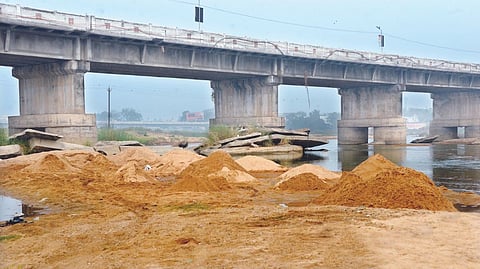Pillaging of Palar continues unabated
VELLORE: The unmitigated and illegal mining of sand from various rivers in the Vellore district has resulted in opposition from the public, especially the village panchayats, who understand the danger they face due to the continued menace.
Though PWD-controlled official quarries are on the Palar River, illegal mining continues in the Malattar in Pernambut and the Kaundanyna river in Gudiyattam. “Where ever river sand is available, illegal mining continues using carts, tipper lorries and tractor trailers. Though public protest and complaints, action is very rarely taken with officials and police in most places being in cahoots with the culprits,” avers a social activist seeking anonymity.
The Palar river is the Vellore district’s lifeline. Having its genesis in the Nandi hills in Karnataka, it crosses Andhra Pradesh and enters Tamil Nadu at Pillur near Vaniyambadi in Tirupattur district and meanders for about 220 kilometres before entering the sea. It traverses slightly more than 100 kilometres in Vellore, Tirupattur and Ranipet districts before entering Kancheepuram district. It is also the only Asian river to have sand to a depth of 70 feet. The reason for illegal mining is the increasing demand for sand for construction. For every tonne of cement used, sand needed amounts to nearly 7 to 8 times more. Those in the know reveal that it takes nearly 500 years for sand to form in a river and indiscriminate mining has resulted in the water table across habitations on the river banks dwindling to 1,000 feet affecting both agriculture and drinking water availability. Related problems due to illegal mining include alteration of the riverbed, changes in the river’s course, eroding of banks, deeper river mouth and estuary and intrusion of seawater, he added.
Governed by section (3) of the Mines and Minerals Development and Regulation Act 1957 (MMDR Act in short), sand mining is overseen by the PWD. “Though rules say that sand should be mined only to a depth of 3 feet, usually it is mined to nearly 15 feet,” sources revealed.
The high profits involved are the reason why ruling party functionaries get into the act, said a source. Though there were cases reported during the AIADMK regime, now ruling party men are known to openly challenge activists as the share goes to all; right to the top. Recently police said they had filed 80 cases for illegal sand mining, but what is surprising is that only small fry are arrested while the big fish who indulge in illegal mining go scot-free due to their proximity to or being ruling party functionaries.
Public outcry against illegal mining silenced by officialdom
The depth to which sand is mined contrary to rules at Somalapuram, Vaniyambadi
Public outcry against illegal mining when manifested has always been overcome by officialdom which comes to the aid of the transgressors.
The most recent was when the public impounded tipper lorries involved in illegal mining in a village in the Anaicut Panchayat Union on May 9, before police intervened, held talks and released the vehicles.
“Though the public is against illegal mining, they are always cowed down,” says former Anpoondi panchayat president M Srinivasan.
On March 22, Vellore was plastered with posters by Viduthalai Chiruthaigal Katchi (VCK) demanding action against three DMK functionaries for abusing the Genganallur panchayat president Senthil Kumar, who opposed illegal mining.
Sand kept in sacks before being illegally transported
In November last year, Perumugai villagers — on the Chennai-Bengaluru National Highway — feared their burial ground would be washed away due to it being converted into an island due to sand being removed from all sides. They thrashed a tractor driver resulting in District Collector P Kumaravel Pandian telling the media that a committee headed by the Vellore AD (mines), including RDO and PWD officials would be formed to look into the issue.
Vellore police also stated that drones would be used to monitor sand movement but whether both were ever done remains a big question mark. Perumugai residents also boycotted the Gram Sabha meeting over this issue.
Social activist M Tamil Selvan of Somalapuram near Vaniyambadi said, “Sand mining came down for a week recently when Tirupattur Collector D Baskara Pandian threatened to book illegal miners under the Goondas Act. But it is back to business as usual now.”
Locals near Pernambut broke the sieves used to distil sand on the Malattar River but were threatened by the mafia who re-grouped after initially running away some months ago. “In all cases, the public aver that there was no official action despite handing over various petitions on this issue,” a Pernambut activist refusing to give his name said.
But the million-rupee question is why Minister for Water Resources Duraimurugan, a Katpadi native, refuses to act despite being aware of such illegal activities.
In January, Kaptadi PU chairman Velumurgan dumped mined sand inside the Vallimalai Government HSS without permission and removed it only after a public outcry.
Visit news.dtnext.in to explore our interactive epaper!
Download the DT Next app for more exciting features!
Click here for iOS
Click here for Android

